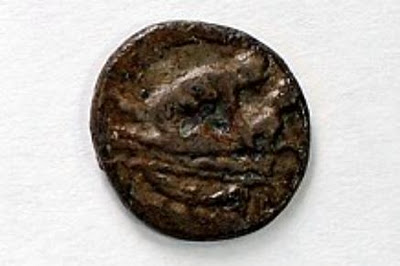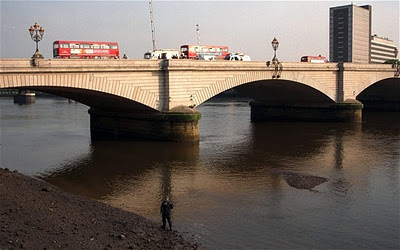A Roman coin that was probably used by a lustful legionary has washed up on the banks of the Thames. 
© Stephanie SchaererThe brothel token is set to go on display at the Museum of London
Made from bronze and smaller than a ten pence piece, the coin depicts a man and a woman engaged in an intimate act.
Historians believe it is the first example of a Roman brothel token to be found in this country.
It lay hidden in mud for almost 2,000 years until it was unearthed by an amateur archaeologist with a metal detector.
On the reverse of the token is the numeral XIIII, which experts say could indicate the holder handed over 14 small Roman coins called asses to buy it.
This would have been the equivalent of seven loaves of bread or one day's pay for a labourer in the first century AD.
The holder would then have taken the token to one of the many Londinium brothels and handed it to a sex slave in exchange for the act depicted on the coin.
The token was found by pastry chef Regis Cursan, 37, who used a metal detector to scan the banks of the Thames near Putney Bridge in West London.
He said: 'The day I made the find it was a very low, early tide and raining heavily. At first I thought it was a Roman coin, because of the thickness and diameter.
'When I rubbed the sand off the artefact the first thing I saw was the number on one side and what I thought was a goddess on the other. Little did I know at the time it was actually a rare Roman brothel token. To find something like that is a truly exciting find.'
The token has been donated to the Museum of London, where it will be on display for the next three months.
Curator Caroline McDonald said: 'This is the only one of its kind ever to be found in Great Britain.

© Eric RobertsThe Roman coin was found near Putney Bridge on the River Thames
'When it came in, it had to be cleaned up before we could make out what it was.
'When we realised it was a saucy picture, we had a bit of a giggle but there's also a sad story behind it because these prostitutes were slaves.
'It has resonance with modern-day London because people are still being sold into the sex trade.' The object, dated to around the first century AD, was protected from corrosion by the mud. Conservationists have spent weeks cleaning it since it was found in September.
Similar tokens have been found elsewhere in the Roman Empire, but this is the first time one has been unearthed in this country.
Experts say there is a possibility it could also be a gaming token - although it would be the only one in Britain to display such an explicit illustration.
Historians believe that the use of a specific image was necessary because many of the brothel slaves would not have been fluent in Latin so needed a picture to know what service their client required.
It is also thought that tokens were a way of ensuring none of the customers' money went directly to the prostitutes.
Experts say it was also illegal to take Roman coins into a brothel during the reign of first century emperor Tiberius as they carried his image.
Mr Cursan, who is executive pastry chef at London restaurant Nobu, made his discovery while volunteering with a group of mudlarks.
Such groups are licensed by the Port of London Authority to search for historical objects which have been lost in the river. Little is known about brothels in Roman Britain, but it is thought that there were both male and female prostitutes available.
Archaeologists have found it hard to pinpoint brothel buildings as they have no distinctive features, although it is thought they existed near Roman baths.
Some historians believe the Romans invented prostitution in the modern sense.
It played a significant part in the empire's economy - with sex workers required to register with the local authorities and even pay tax.
Source: The Daily Mail/UK
Reader Comments